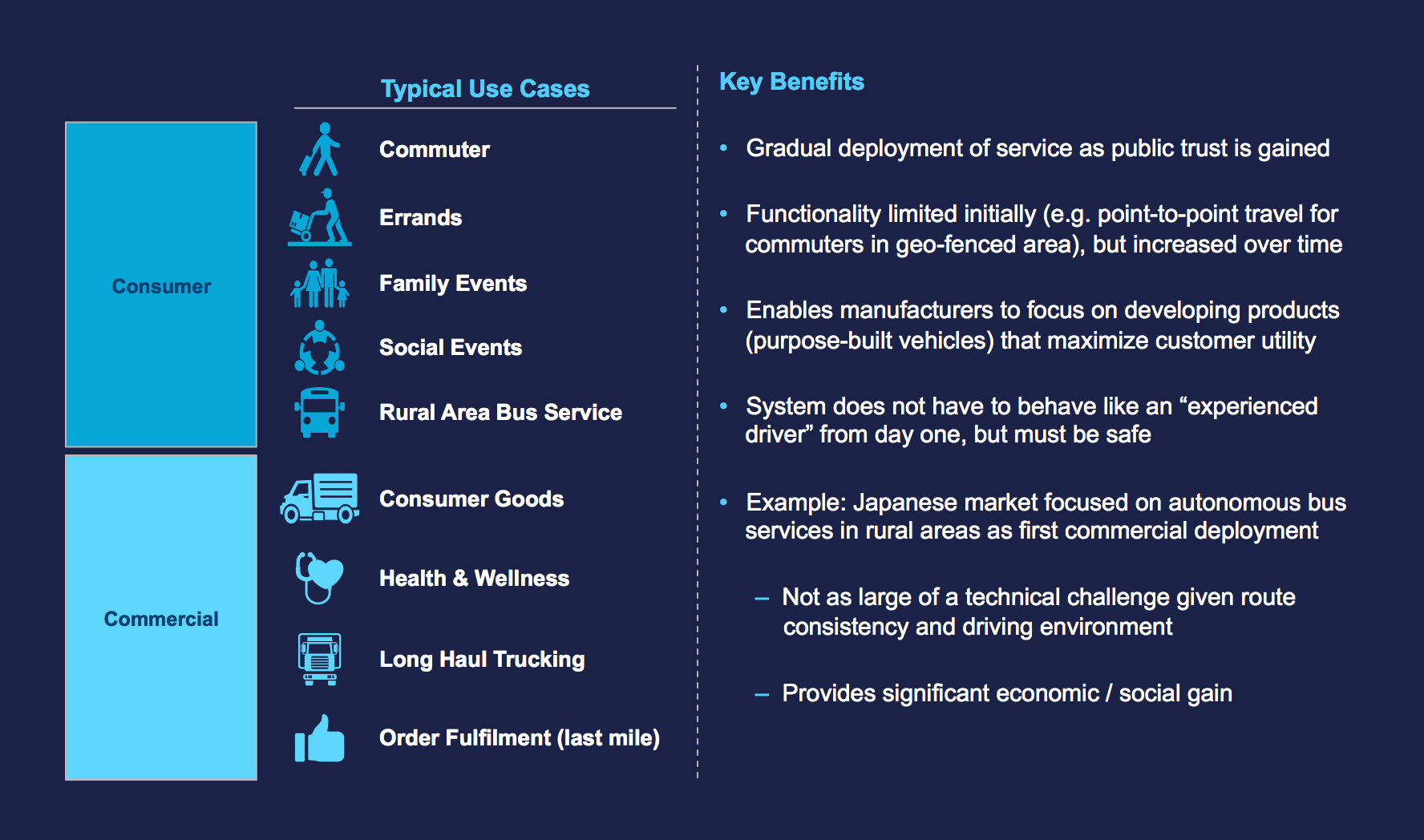
The 2018 Emotion AI Summit hosted by Affectiva brought the autonomous vehicle as one of the many thought-provoking topics in which AI is used today. The panel session entitled “Building Trust in Next Generation Vehicles” was moderated by Regina Savage, Managing Director at Morgan Stanley. Panelists included Ola Bostrom, Ph.D., VP of Research & Patents at Veoneer, Karl Iagnemma, Ph.D., President & Co-Founder, nuTonomy (acquired by Aptiv) and Bryan Reimer, Ph.D., Research Scientist at MIT AgeLab & Associate Director at the New England University Transportation Center.
Before the panel discussion began, moderator Regina Savage of Morgan Stanley delivered a panel introduction on automotive trends to frame the moderated panel discussion. She started with addressing the challenge of building trust in next generation vehicles. The barrier for trusting a fully autonomous vehicle with your life for the life of your children is actually quite high - and in many respects, it's higher than the trust that you need to place in another human driver or in yourself.
As we think about that and the disruption that autonomous vehicles will bring to the entire industry, there are really critical questions that must be grappled with. How do automotive companies roll out new technology? What is the pace of that change? What needs to be done to encourage people to accept and adopt this technology? What missteps should be avoided on how this technology is rolled out? All of these pieces are critical in affecting whether or not we will have trust in these vehicles, as well as the pace of and rate of adoption of that change.

Trust in Vehicles: Service + Commercial Use Cases
From an industry perspective, the automotive industry as a whole is facing a seismic shift in how consumers are interacting with the vehicle. Traditionally, consumers thought about vehicles as a product to purchase, that has a brand associated with it, and has features that you might find attractive.
Now, this process is shifting to the idea of service-based products. For example, consumers might ask: what do I need to get myself around? As a commuter, what are the different options that I need? What are the features that are relevant for me? What's necessary for me to run errands? Can I outsource that to an outside service (i.e., grocery deliveries like Peapod)? What do I need to cart my entire family to the beach, or to take them to their sporting practices?
On the commercial side, there is a similar change in thought process: how do you transport consumer goods? How can we get time-sensitive goods, perhaps related to health and wellness, to arrive faster?
Thinking about these emerging service and commercial use cases is dominating the conversation about where the automobile evolution is headed. There is also a gradual deployment of these services, in part because the technology needs to evolve but even more significantly, because that's what's necessary for the consumer to gain trust of this new technology. That's why you're seeing these initial roll-outs in very limited areas.

The other thing that's important is that the system doesn't necessarily have to act like an experienced driver on day one: but it does have to be something that you are confident engaging with on day one. Consumers also must believe that there's constant safety - which would evolve over time, and that's critical to how we think about this evolution.
Trust through the Levels of Autonomy
The progression of vehicle autonomous technology begins with what is currently active in consumer vehicles today - features that make you feel more safe, such as blind spot detection, or your “backing up” rear-view camera. These capabilities fall in the spectrum of Level 1 / Level 2 automation, designed to assist the driver or partially automate basic activities to increase safety.
Level 3 automation is where vehicles take over and drive themselves, but the driver still is able to take back control. When it comes to trusting a Level 3 system, there's a lot of skepticism over whether or not it is practical, or deploying features like this are actually going to backfire and set back the adoption of this technology over time.
Finally, the more fantastic areas of this technology are in the Level 4 / 5 category, where a vehicle is truly is driving itself. It may or may not have a steering wheel, but a human driver is no longer necessary - which is the ultimate goal of many of these emerging technologies.

Engaging with and Adoption of Technology Across the Automotive Spectrum: Trusting TOO much?
There are a two overarching concerns when examining this autonomous driving technology: from the most basic questions of how good the technology is, does it work, and does it fulfill certain functions, etc. But then there's a secondary question of how does it work and how well do we as consumers think that it reacts and acts relative in comparison to a human driver.
For example, will driving in one of the more automated levels of vehicle make you look like a student driver? That can vary from the driver being uneasy to the car itself not being confident in what it's doing. The goal is to reach the point where the car on its own is an experienced driver that really understands that nuances of the specific hyper-locale and the rules of the neighborhood that it's operating in.
These are the different levels that the technology companies that are trying to evolve this technology are really grappling with. It's an interesting intersection from the question of trust because if this technology is rolled out and it isn't safe enough, or is trying to act too advanced in terms of the social interaction with the driver or externally with pedestrians, this will significantly impact people's ability to trust that vehicle and the technology overall.
Level 1 / 2 adoption in the assisted driving technology on the market today is all about consumer perception of improving safety. This then evolves into the critical question of, does it impact the driver's driving habits in a way that continue that safety even when they're in a vehicle that doesn't have that feature, or if that feature isn't completely working? For example, if the primary vehicle you are used to driving has blind spot detection that you have come to rely on, what happens when you get into a car that doesn't have that feature?
When approaching Level 3, you have the same questions and challenges. Does it improve safety along with convenience? And do you create this false sense of security by trusting the technology too much? By “turning ourselves off,” we would not be able to effectively react if the vehicle actually needs us to engage.
On Level 4 / 5, we directly ask the question, is it safe, and do I trust it? If yes, the follow up questions shift entirely - is it reliable? Does it meet my use case and needs? Is it available when I need it to be? This evolves the conversation to be more about experience, and AI can be really instructive in how to keep it moving forward.
The Bottom line:
Safety is Table Stakes for Trust.
Ultimately, there is an evolution of different offerings. Today, we are coming from a world where mobility services, such as the ridesharing company you use may be based on whether or not the network is available, what the price is, or the on brand reputation. For car ownership, you are focused on your overall experience, brand reputation and price, but that car you are buying is still just a product. Then when considering sensor technology and HMI mapping automation software, it becomes about how well does it work, and does it really improve the functioning of your vehicle?
What we're looking for in this evolution is differentiation: in Level 4 / 5, there is not a question of safety as a measurement. Because the implication here is that for us to accept the technology at all, we have to believe that it's safe in all respects. You’ll look other factors such as overall occupant experience to differentiate on which services you're willing to adopt.
Interested in learning more? Download the session recordings from the Emotion AI Summit, where this panel discusses establishing safety and trust in autonomous technology so we can evolve into mass adoption of autonomous vehicles in the future.






